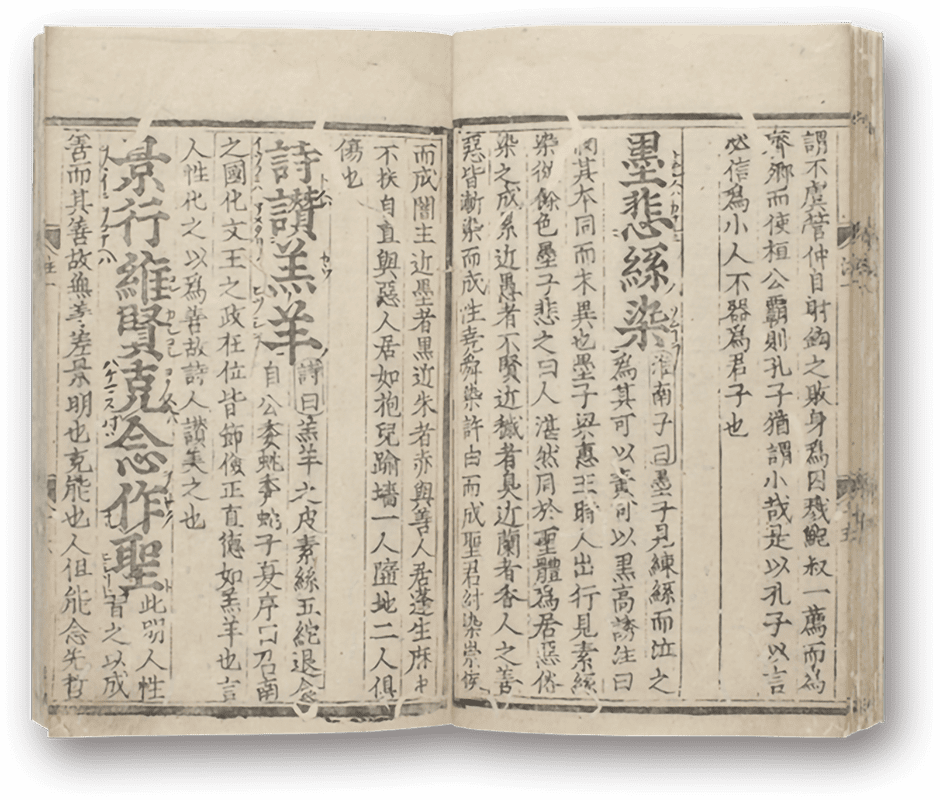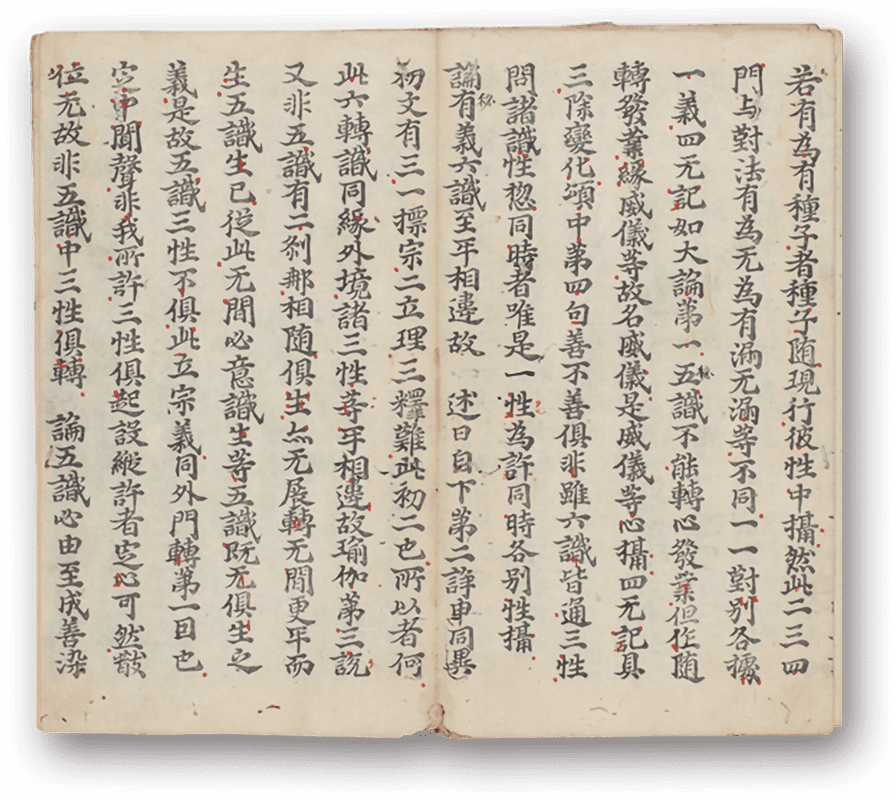Printed Books in Each Period - 各時代の版本
The number of printed books in Japan had been increasing since the late Heian period, but it is since the Kamakura period that many books have been inherited until today. The following exhibit shows printed books in the Kamakura and subsequent periods.日本の版本は、平安時代後半以降その事例が増えますが、遺品が多く残るのは鎌倉時代からです。ここでは、鎌倉時代以降各時代の版本の例を展示します。
Kohanpon - 古版本
Kohanpon means printed books before the Muromachi period. Many kohanpon books were published by Buddhist temples and named after the temple or Buddhist sect.室町時代以前の版本を、古版本と呼びます。古版本の多くは寺院で出版されたもので、寺院や宗派による名称が付けられています。
Kohanpon - 古版本
Kasuga-ban - 春日版
Books published by Kofukuji Temple in Nara since around the end of the Heian period. They are commonly called kasuga-ban because their kanki often declares faith in the god of Kasuga, the guardian deity of the Hosso sect. Kasuga-ban books mainly consist of sutras, doctrines and their commentaries related to the Hosso sect.平安末期頃から奈良の興福寺で出版された本で、しばしば刊記に法相宗の守護神である春日の神への信仰が表明されていることから、春日版と通称される。法相宗関係の経論やその注釈書が主体。
Kohanpon - 古版本

Daibirushana Jōbutsu Jinben Kajikyō - 大毘盧遮那成仏神変加持経
Kōya-ban - 高野版
Books published at Mt. Kōya since the middle Kamakura period, mainly consisting of sutras and doctrines related to the Shingon sect, as well as books by Kobo Daishi. Sasshibon books are characterized by being bound in decchoso and using thick choshi called Koya paper.鎌倉中期から高野山で出版された本で、弘法大師の著作を初め、真言宗関係の経典や教理書が中心。冊子本は粘葉装に装訂され、高野紙という厚手の楮紙を用いるのが特色。
Kohanpon - 古版本

Senjimon Chū - 千字文註
Gozan-ban - 五山版
Books that were published since the middle Kamakura period by the Five Mountains in Kyoto and Kamakura and other zen temples. They are characterized by many Chinese books along with Buddhist books and they have a strong influence from Chinese and Korean printed books.鎌倉中期から、京都と鎌倉の五山を初めとする禅宗寺院で出版された本で、仏書のほか漢籍なども少なくないことと、中国や朝鮮の版本の強い影響が見られることが特色。
Kokatsujibon - 古活字本
From the end of the 16th century to the middle of the 17th century, many books were made by mainly printing with wooden movable type. These books are called kokatsujibon, some of which have a name specific to the place of publication.十六世紀の終わりから十七世紀の半ばにかけて、主に木製の活字を用いて印刷した本が多数作られました。これを古活字本と言い、出版地などによる特定の名称を持つものがあります。
Kokatsujibon - 古活字本

Kōchō Ruien - 皇朝類苑
Chokuhan - 勅版
Books published by imperial command, including Bunroku chokuhan (Kobun Kokyo , 1593, not extant) and Keichō chokuhan (Nihonshoki Jindai no Maki , Rongo , etc., 1597–1603) by Emperor Go-Yozei and Gen'na chokuhan (Kocho Ruien , 1621) by Emperor Go-Mizunoo.天皇が命じて出版させた本。後陽成天皇による文禄勅版(文禄2年〔1593〕刊『古文孝経』、現存せず)と慶長勅版(慶長2年〔1597〕~8年刊『日本書紀神代巻』『論語』など)、後水尾天皇による元和勅版(元和7年〔1621〕刊『皇朝類苑』)がある。
Kokatsujibon - 古活字本
Saga-bon - 嵯峨本
A group of printed books that have the Koetsu-style movable type face invented by Hon'ami Koetsu (most of them are kokatsujibon) is generally called saga-bon because those books were allegedly published with financial support from Suminokura Soan in Saga, Kyoto. However, the involvement of Koetsu and Soan is only supposed because there is no evidence for it.本阿弥光悦の創始した光悦流の書体を持つ一群の版本(大半は古活字本)は、嵯峨の角倉素庵の資金援助で出版されたと言われることから、嵯峨本と通称されている。ただし光悦と素庵の関与については明証がなく、想像にとどまる。
Kokatsujibon - 古活字本

Fushimi-ban - 伏見版
Books printed in movable type primarily at Enkō-ji in Fushimi by Tokugawa Ieyasu from Keichō 4 (1599) to 11, including well-known works such as "Seigenshōyō," "Azumakagami," "Zhouyi," and "Shichisho."徳川家康が慶長四年(1599)から十一年にかけ、主に伏見の円光寺で活字により出版させた本。『貞観政要』『吾妻鏡』『周易』『七書』などが知られる。
Kokatsujibon - 古活字本

Ōjōyōshū Shō - 往生要集抄
Eizan-ban - 叡山版
Books published at Mt. Hiei. While some books published in the Kamakura period are also called so, this term generally means kokatsujibon books that were published during the Keichō to Kan'ei periods. This category mainly consists of Buddhist books related to the Tendai sect.比叡山で出版された本。鎌倉時代にもあるが、一般には慶長~寛永期に出版された古活字本を指す。天台宗関係の仏書が中心。
Kokatsujibon - 古活字本
Kokatsujibon in the Keichō and Gen'na Periods - 慶長元和期の古活字本
Kokatsujibon in the Keichō and Gen'na periods when old movable type printing flourished, generally in a larger format with larger characters than ones in the subsequent Kan'ei period.古活字印刷が隆盛を迎えた慶長~元和期の古活字本で、後の寛永期のものより概して書型が大きく、文字も大ぶりである。
Seihanbon in the Edo Period - 江戸時代の整版本
Seihanbon in the Edo Period - 江戸時代の整版本
From around the middle of the 17th century when old movable type printing ceased to flourish, seihanbon dominated again. Printing plates with tangled pictures and characters or waka poems written irregularly are unique to seihanbon and difficult for kokatsujibon.古活字本の隆盛が終わった十七世紀半ば以降、再び整版本が主流になりました。古活字本では困難な、絵と文字が入り組んだり、和歌を散らし書きした版面は、整版本ならではのものです。
Early Modern and Modern Mokkatsujibon - 近世~近代の木活字本
Early Modern and Modern Mokkatsujibon - 近世~近代の木活字本
Books printed with wooden movable type were made from the late Edo period to the Meiji period. These are called early modern (modern) mokkatsujibon.江戸時代後期から明治時代にかけて、木製の活字で印刷した本が作られました。これを近世(近代)木活字本と言います。
Modern Seihanbon - 近代の整版本
Modern Seihanbon - 近代の整版本
In the Meiji period, seihanbon books were still made by the same method used for those in the Edo period. However, it seems that publication of new books printed by wooden printing blocks almost disappeared around the Taisho period.明治時代になっても、江戸時代と同じ方法で整版本が作られていました。しかし木版印刷による新刊本は、大正頃にはほぼ消滅したようです。
Japanese Style Modern Books Printed with Metal Movable Type - 近代の和装 金属活字本
Japanese Style Modern Books Printed with Metal Movable Type - 近代の和装 金属活字本
In the Meiji period, many books were printed by a new method of metal movable type printing and bound in the Japanese-style traditional fukurotoji format.明治時代には、金属活字版という新しい方法で印刷し、伝統的な袋綴の和装本に仕立てた本も多数作られました。









